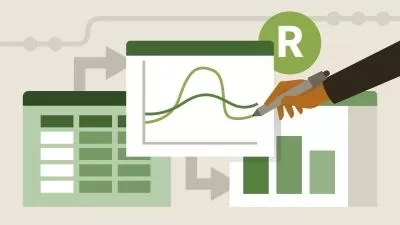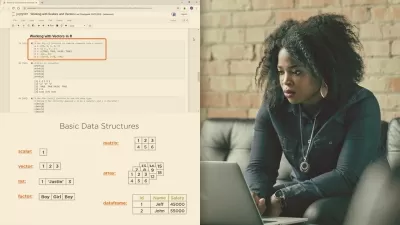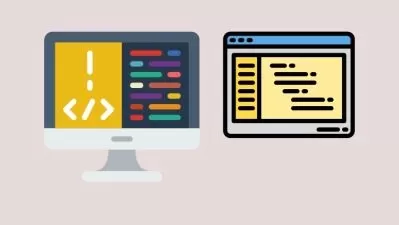R Programming for Data Science and Machine Learning
The Tech X Learners
7:19:39
Description
Learn R Programming Language for Data Science, Machine Learning, Data Analysis and Data Visualization with Libraries
What You'll Learn?
- R Programming Language
- Data Manipulation with R Language
- Data Visualization with R Language
- Machine Learning with R Language
- Supervised Learning with R Language
- Unsupervised Learning with R Language
- Data Analytics with R Language
Who is this for?
More details
DescriptionR LANGUAGE
R language is an open-source programming language that is used for statistical analysis and graphical representation. It was developed by Ross Ihaka and Robert Gentleman, at the University of Auckland, New Zealand. R contains a large and coherent system of statistical and graphical techniques that can be used for data analysis. It provides a well-defined environment for reproducible research.
R is an implementation of S programming language, inspired by Scheme. A lot of data scientists, statisticians, analysts etc. use R to make sense of the data and then use it for data analysis, predictive analysis and data visualization. The data analysis can be done by writing scripts and functions in R language. It is an object-oriented language that provides modeling, exploring and visualizing of the data. The process of data analysis is usually done in a few lines of code. R provides all the functions regarding data manipulation, statistical model or chart that an analyst could need. It includes machine learning algorithms, linear aggression, time series, statistical interference etc. R is written in its own language which makes programmers to understand the format easily, but for heavy computations it collaborates with C, C++, Python, etc.
Features
· Open-source
R language provides an open-source, free of cost platform. It is licensed by GNU, General Public License, this means that anyone can download it and make changes in it according to the prerequisites. Many other packages are available under the same license and can be downloaded easily.
· Runs on all platforms
It supports cross-platform operations, this means that the software operates correctly on all other platforms i.e. Windows, Linux and Mac. Technology that functions on all platforms has multiple benefits to reap in today’s computing world.
· Fast calculation
With the help of R, you can carry a vast variety of complex operations on vectors, arrays, and other objects. These objects perform rapidly which allows the programmers to carry out these calculations easily.
· Compatible
It is highly compatible with other programming languages. It can use C or C++ for complex tasks. Java and Python can also be used for heavy tasks. Other than that, R is compatible with other data processing technologies as well. It can be easily paired with Hadoop or Spark to process large data.
· Extensible
The extensible feature of R makes it capable of being used in a variety of fields. It is used by lots of data scientists and data miners for feasibility. R is widely used in Machine Learning, Data Science and Artificial Intelligence for better data processing and analyzing.
· Graphical capabilities
R is capable of producing static graphics with good quality visualization and had libraries that provides graphical capabilities. This makes data visualization and representation quite handy.
· Complex statistical computations
R is designed to perform simple and complex statistical and mathematical computations. It can perform these operations on big data as well.
· Large user base
The open-source library of R provides a huge reason for the software’s large number of supporters. The highly active community of the software is the key to its massive growth.
· Variety of data
R’s remarkable storage and data handling techniques allows it to handle a variety of structured and unstructured data. It also provides data operation and data modeling facilities due to the interaction with storage facility.
Application of R
R has played a huge role in shaping the industries. As artificial intelligence and machine learning are the backbone of the businesses nowadays, R is a basic component of artificial intelligence and machine learning. The companies opt for R because it is easy to learn. If you want the best insights from the data, it is necessary to spend time in learning the appropriate language for accurate outputs and R provides all the essential tools and techniques that are required. Following are some of the major applications of R:
1. Fundamental tool for finance
R is one of the most used languages in finance. The statistical computation reaps many benefits to the data scientists in the field. R provides the facilities of data mining that is extremely useful. It is also widely used for credit risk analysis. The statistical processes provided by the software are used to determine the movement of stock market and predict the future prices of shares.
2. Data science
R is a popular language in the field of data science. The valuable techniques of statistical computations and graphics prove to be extremely beneficial for data scientists. It is widely used by data statisticians and data miners all over the world.
3. Data importing and cleaning
The software is commonly used by the quantitative analysts and helps in data importing and cleaning.
4. Healthcare
R is extensively used in the healthcare industry for data analysis and processing. It is used to design clinical trials, compare therapies, evaluate drugs by running PD analysis, run data validation against errors and frauds, transform data into various formats etc.
5. Social media
The social media data can be analyzed using R. You can perform network analysis as well. The data can be extracted and explored how to derive insights for social media analyzing. It is also useful in machine learning and natural language processing. Sentiment analysis and other forms of data mining is also performed using R.
6. E-commerce
E-commerce is one of the most important industries that use R as a standard language. These companies are formed on internet and have to deal with a variety of data that may be structured or unstructured. These companies also have to deal with various data sources (SQL or NoSQL), R provides lucrative techniques for both of these. E-commerce companies also utilize R for analyzing the recommendations and suggestions given by the customers in prospectus of cross-selling products.
7. Machine Learning
With the aid of R, predictive models can be developed that can be beneficial to use machine learning algorithms to predict future occurrences, trends and patterns.
R vs Python
R and Python are both open-source programming languages. R is mainly used for statistical analysis while Python is more suitable for use in data science. Python is mainly used by programmers and developers, while R is mostly used by scholars and R&D. R is difficult to learn in the beginning while Python is commonly recommended to beginners due to its easy-to-use syntax. R has a huge library that is easy to use, Python does not have as much of a large library. However, in language terms, Python is far better. On the other hand, R is far more manageable after reaching the tidy verse packages. This library proves to be really powerful in terms of cleaning. Being a general-purpose language, Python makes it easier to be apart of large infrastructure. Moreover, R has more advanced graphical capabilities. If we discuss speed, then R is designed to be slow to make statistical analysis and computations easier and lacks in visualization as well. In comparison, both are with equal benefits in data handling capabilities, job opportunities and support and community. Where a lot of deep learning research is done in Python, a lot of statistical modeling research is conducted in R. Google trends’ graph concludes the task by showing which of the two is more popular. It is vividly displayed that Python is more demanded than R in the market.
R vs SAS
SAS is the abbreviation of Statistical Analysis Software and is used in data analytics. It helps you use techniques to enhance employee productive and increase business profits. SAS can be used to access raw data files, analyze data, help manage data entry, formatting, editing and to help businesses know their historical data. R provides programming platform for data analytics or statistical analysis. It can run on various platforms and provides interactive graphical capabilities. SAS is a commercial software that needs investment, while R is free of cost. R needs lengthy codes to operate as compared to SAS, which is the easiest tool to learn. R is a continuously updated tool, while SAS is less updated. SAS has better graphical capabilities than R. SAS provides a committed customer support while R has no customer support system. Moreover, R provides advanced deep learning integration than SAS. You can share files with anyone while using R, on the other hand, with SAS you cannot share files unless the user is also using SAS. In terms of handling and managing data, SAS is at a better position since massive amounts of data is generated on daily basis. Due to better graphical representation and being the market leader in corporate jobs, SAS is quite expensive for startups. Google trends summarize the differentiation with this graph.
R vs SPSS
SPSS stands for Statistical Package for Social Sciences and is used for complex statistical data analysis. These are two industry-leading technologies for analyzing data. For learning and practicing analytics, R is the best programming language, while SPSS has more of a user-friendly interface. For decision making, SPSS is a better software than R because it does not offer many algorithm trees. R has one of the strongest open source communities, SPSS lacks behind. R is written in C, while SPSS is written Java. SPSS is not free; you can use free trial period and then have to pay the subscription fee while R is downloadable for free. R offers more opportunities for visualization than SPSS. The graphs are easily made interactive using R that attracts users, SPSS can be a little shaky. Google trends demonstrated the more trending software out of the two and is easily visible that R functions better than SPSS and is more popular among the audiences.
Conclusion
R has a great career potential. It’s excellent graphical and statistical computations and wide range of visualization techniques make it worth using. It’s a great tool for data and statistical analysis which makes it highly demanded in the market. It indeed has a tough competition but it’s unique benefits and uses results in it having its own name in the industry.
Who this course is for:
- Students who are interested in Data Science
- Students who are interested in Data Analysis
- Students who are interested in R Language
- Students who are interested in Machine Learning
- Students who are interested in Data Analytics
R LANGUAGE
R language is an open-source programming language that is used for statistical analysis and graphical representation. It was developed by Ross Ihaka and Robert Gentleman, at the University of Auckland, New Zealand. R contains a large and coherent system of statistical and graphical techniques that can be used for data analysis. It provides a well-defined environment for reproducible research.
R is an implementation of S programming language, inspired by Scheme. A lot of data scientists, statisticians, analysts etc. use R to make sense of the data and then use it for data analysis, predictive analysis and data visualization. The data analysis can be done by writing scripts and functions in R language. It is an object-oriented language that provides modeling, exploring and visualizing of the data. The process of data analysis is usually done in a few lines of code. R provides all the functions regarding data manipulation, statistical model or chart that an analyst could need. It includes machine learning algorithms, linear aggression, time series, statistical interference etc. R is written in its own language which makes programmers to understand the format easily, but for heavy computations it collaborates with C, C++, Python, etc.
Features
· Open-source
R language provides an open-source, free of cost platform. It is licensed by GNU, General Public License, this means that anyone can download it and make changes in it according to the prerequisites. Many other packages are available under the same license and can be downloaded easily.
· Runs on all platforms
It supports cross-platform operations, this means that the software operates correctly on all other platforms i.e. Windows, Linux and Mac. Technology that functions on all platforms has multiple benefits to reap in today’s computing world.
· Fast calculation
With the help of R, you can carry a vast variety of complex operations on vectors, arrays, and other objects. These objects perform rapidly which allows the programmers to carry out these calculations easily.
· Compatible
It is highly compatible with other programming languages. It can use C or C++ for complex tasks. Java and Python can also be used for heavy tasks. Other than that, R is compatible with other data processing technologies as well. It can be easily paired with Hadoop or Spark to process large data.
· Extensible
The extensible feature of R makes it capable of being used in a variety of fields. It is used by lots of data scientists and data miners for feasibility. R is widely used in Machine Learning, Data Science and Artificial Intelligence for better data processing and analyzing.
· Graphical capabilities
R is capable of producing static graphics with good quality visualization and had libraries that provides graphical capabilities. This makes data visualization and representation quite handy.
· Complex statistical computations
R is designed to perform simple and complex statistical and mathematical computations. It can perform these operations on big data as well.
· Large user base
The open-source library of R provides a huge reason for the software’s large number of supporters. The highly active community of the software is the key to its massive growth.
· Variety of data
R’s remarkable storage and data handling techniques allows it to handle a variety of structured and unstructured data. It also provides data operation and data modeling facilities due to the interaction with storage facility.
Application of R
R has played a huge role in shaping the industries. As artificial intelligence and machine learning are the backbone of the businesses nowadays, R is a basic component of artificial intelligence and machine learning. The companies opt for R because it is easy to learn. If you want the best insights from the data, it is necessary to spend time in learning the appropriate language for accurate outputs and R provides all the essential tools and techniques that are required. Following are some of the major applications of R:
1. Fundamental tool for finance
R is one of the most used languages in finance. The statistical computation reaps many benefits to the data scientists in the field. R provides the facilities of data mining that is extremely useful. It is also widely used for credit risk analysis. The statistical processes provided by the software are used to determine the movement of stock market and predict the future prices of shares.
2. Data science
R is a popular language in the field of data science. The valuable techniques of statistical computations and graphics prove to be extremely beneficial for data scientists. It is widely used by data statisticians and data miners all over the world.
3. Data importing and cleaning
The software is commonly used by the quantitative analysts and helps in data importing and cleaning.
4. Healthcare
R is extensively used in the healthcare industry for data analysis and processing. It is used to design clinical trials, compare therapies, evaluate drugs by running PD analysis, run data validation against errors and frauds, transform data into various formats etc.
5. Social media
The social media data can be analyzed using R. You can perform network analysis as well. The data can be extracted and explored how to derive insights for social media analyzing. It is also useful in machine learning and natural language processing. Sentiment analysis and other forms of data mining is also performed using R.
6. E-commerce
E-commerce is one of the most important industries that use R as a standard language. These companies are formed on internet and have to deal with a variety of data that may be structured or unstructured. These companies also have to deal with various data sources (SQL or NoSQL), R provides lucrative techniques for both of these. E-commerce companies also utilize R for analyzing the recommendations and suggestions given by the customers in prospectus of cross-selling products.
7. Machine Learning
With the aid of R, predictive models can be developed that can be beneficial to use machine learning algorithms to predict future occurrences, trends and patterns.
R vs Python
R and Python are both open-source programming languages. R is mainly used for statistical analysis while Python is more suitable for use in data science. Python is mainly used by programmers and developers, while R is mostly used by scholars and R&D. R is difficult to learn in the beginning while Python is commonly recommended to beginners due to its easy-to-use syntax. R has a huge library that is easy to use, Python does not have as much of a large library. However, in language terms, Python is far better. On the other hand, R is far more manageable after reaching the tidy verse packages. This library proves to be really powerful in terms of cleaning. Being a general-purpose language, Python makes it easier to be apart of large infrastructure. Moreover, R has more advanced graphical capabilities. If we discuss speed, then R is designed to be slow to make statistical analysis and computations easier and lacks in visualization as well. In comparison, both are with equal benefits in data handling capabilities, job opportunities and support and community. Where a lot of deep learning research is done in Python, a lot of statistical modeling research is conducted in R. Google trends’ graph concludes the task by showing which of the two is more popular. It is vividly displayed that Python is more demanded than R in the market.
R vs SAS
SAS is the abbreviation of Statistical Analysis Software and is used in data analytics. It helps you use techniques to enhance employee productive and increase business profits. SAS can be used to access raw data files, analyze data, help manage data entry, formatting, editing and to help businesses know their historical data. R provides programming platform for data analytics or statistical analysis. It can run on various platforms and provides interactive graphical capabilities. SAS is a commercial software that needs investment, while R is free of cost. R needs lengthy codes to operate as compared to SAS, which is the easiest tool to learn. R is a continuously updated tool, while SAS is less updated. SAS has better graphical capabilities than R. SAS provides a committed customer support while R has no customer support system. Moreover, R provides advanced deep learning integration than SAS. You can share files with anyone while using R, on the other hand, with SAS you cannot share files unless the user is also using SAS. In terms of handling and managing data, SAS is at a better position since massive amounts of data is generated on daily basis. Due to better graphical representation and being the market leader in corporate jobs, SAS is quite expensive for startups. Google trends summarize the differentiation with this graph.
R vs SPSS
SPSS stands for Statistical Package for Social Sciences and is used for complex statistical data analysis. These are two industry-leading technologies for analyzing data. For learning and practicing analytics, R is the best programming language, while SPSS has more of a user-friendly interface. For decision making, SPSS is a better software than R because it does not offer many algorithm trees. R has one of the strongest open source communities, SPSS lacks behind. R is written in C, while SPSS is written Java. SPSS is not free; you can use free trial period and then have to pay the subscription fee while R is downloadable for free. R offers more opportunities for visualization than SPSS. The graphs are easily made interactive using R that attracts users, SPSS can be a little shaky. Google trends demonstrated the more trending software out of the two and is easily visible that R functions better than SPSS and is more popular among the audiences.
Conclusion
R has a great career potential. It’s excellent graphical and statistical computations and wide range of visualization techniques make it worth using. It’s a great tool for data and statistical analysis which makes it highly demanded in the market. It indeed has a tough competition but it’s unique benefits and uses results in it having its own name in the industry.
Who this course is for:
- Students who are interested in Data Science
- Students who are interested in Data Analysis
- Students who are interested in R Language
- Students who are interested in Machine Learning
- Students who are interested in Data Analytics
User Reviews
Rating
The Tech X Learners
Instructor's Courses
Udemy
View courses Udemy- language english
- Training sessions 87
- duration 7:19:39
- English subtitles has
- Release Date 2023/03/16






















